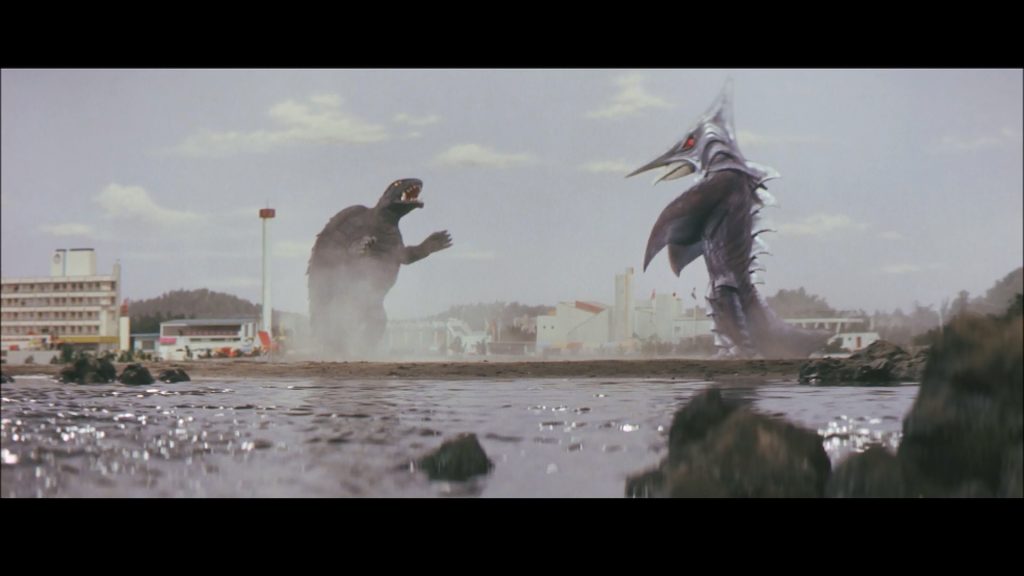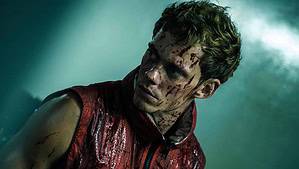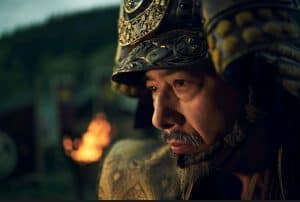As giant monsters rampaged the Japanese cinematic landscape during the “kaiju boom” of the mid-1960s, Daiei Studios introduced a new character to the screen that would be embraced for generations: Gamera, the giant, flying, fire-breathing turtle, and friend of all children! Buried under the Arctic ice for several millennia, the colossal chelonian is unleashed upon Japan, leaving havoc in his wake. After becoming an unexpected box office sensation, Gamera returned several more times, leaping to the world’s defence against a motley assortment of evil creatures, from the death-ray-shooting flying terror Gyaos, to the knife-headed alien menace Guiron, to the underwater invader Zigra!
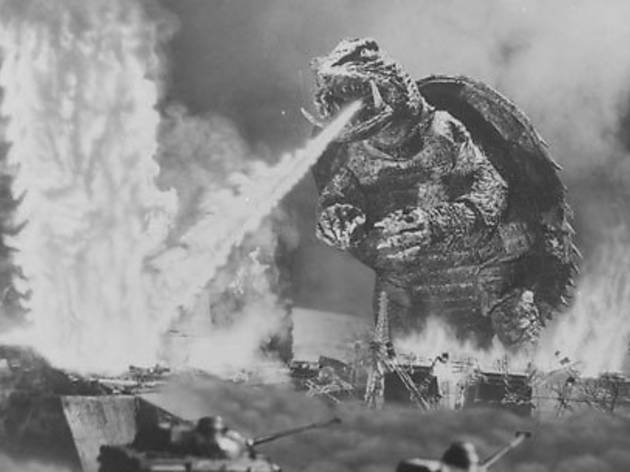
Disc One
Gamera The Giant Monster (1965)
A nuclear explosion in the far north unleashes Gamera, the legendary flying turtle, from his sleep under the ice. In his search for energy, Gamera wreaks havoc over the entire world, and it’s up to the scientists, assisted by a young boy with a strange sympathetic link to the monster, to put a stop to Gamera’s rampage.
This initial entry into the iconic franchise is not particularly beloved by any particular group, but it is a film that deserves respect for what it accomplishes. Sure, the film makes no attempt to cover for its glaring lack of budget, but that is part of the charm for this fan. The special effects are shoddy and the seams of the production are on full display, but do you really need to have your destructive, giant fire-breathing turtle be perfect? As opposed to subsequent installments, ole Gamera gets a chance to be the monster who inspires fear in the masses as opposed to the savior of the world against formidable foes. The human element on display is not substantially smarter than normal, and the lead child in the film makes some baffling decisions in terms of self-preservation. At less than 80 minutes, this film really flies by as it tries to stave off the monotonous plot with something to capture the audience’s attention. The plot development is nothing groundbreaking, but this debut entry of copycat kaiju goodness is a fun time.
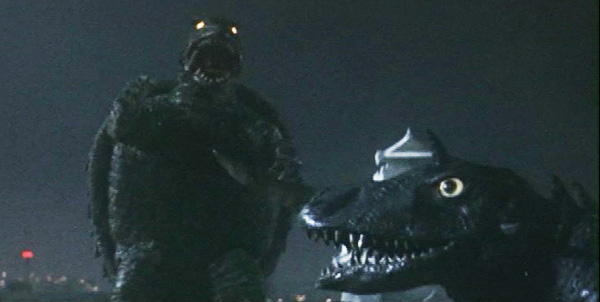
Disc Two
Gamera Vs. Barugon (1966)
After a treacherous expedition to retrieve a giant opal, disaster strikes as the opal reveals itself to be an egg which spawns Barugon, demon dog from Hell! Armed with a deadly tongue and cold beams, Barugon wreaks havoc on Japan. Gamera comes to save the day.
The second installment of the franchise doubles the fun by introducing a foe for Gamera to track down and dispatch. Not only do we get increased monster destruction this time out, but we get to witness it in color. The film starts out with a quick recap to get the audience up to speed – not that a film such as this needs a detailed plot analysis – and undoes the final act of the initial installment. If we are going to have this badass terrapin saving us from malicious monsters, we cannot have him floating off into space. The creative team went for the obvious foil for our fire-breathing Gamera, which would obviously be the ice-creature Barugon. This is when the series starts to make its transition to a focus more on children, but overall this feels more adult than the rest of the Showa run. The movie is not perfect – not even close – as it does commit the cardinal sin of being overly long and drawn out. You know what you want out of a kaiju film, so it only frustrates you when the film tries to get you to care about the human element. None of these characters are ever going to be as interesting as Gamera, so you really just want to get to the showdown of fire vs. ice.

Gamera Vs. Gyaos (1967)
Gamera’s back, and just in time to save Japan from Gyaos, a mysterious bat-like creature awakened by a volcanic eruption. As in the first Gamera movie, a young boy establishes an emotional link with Gamera, and the two work together, with the help of the world’s scientists, to put an end to Gyaos’ violent rampage.
The third entry into the series is completely ridiculous, but I could not help but enjoy it quite a bit for the outlandish piece of entertainment that it is. More than any time previously, Gamera is seen as a helpful figure of good who seems to look out for the safety of children. The opposition this time around is a seemingly indestructible death-dealing vampire bat of a creature who can shoot lasers that will cut straight through metal. One of the recurring gags in the film is the beam cutting either an airplane or car clean in two. These moments go a great deal towards underlining some of the issues with the film, including the over-the-top way they treat the threat rather than have something with a bit of menace. I love a good bad special effect in a film, but the creative team barely seem to be trying when it comes to Gyaos. When the creature is not flying around, it appears much more menacing, especially when it is devouring humans whole. Gyaos is most terrifying when it nearly slices one of Gamera’s limbs off with its laser beams. The script is pretty standard monster fare that goes in circles until you reach the only conclusion the film like this could have. This entry is not genuinely great, but it has some fun moments that make this one a guilty pleasure, if you subscribe to a belief in such a thing.

Disc Three
Gamera Vs. Viras (1968)
A group of aliens from another planet head for Earth with the intentions of conquering it. Their first ship is destroyed in transit by the giant flying turtle Gamera. A second ship makes it to Earth and captures two Boy Scouts and holds them captive so that Gamera will not attack them. The aliens then implant a remote control device into the monster’s neck and use the great turtle to attack Tokyo. The boys then come up with a plan to foul up the remote control device to the point where Gamera does the opposite of what he is ordered to. As a result Gamera destroys the aliens ship, but then has to contend with their giant squid like leader Viras.
This entry starts out with quite the bang as you get some prime Gamera action before the title even appears via some spaceship destruction. From here, elements are introduced that will come to define the remainder of the Showa run. There is already a new element with the focus on aliens and space, but it is the stark shifting of the focus to the children that is most frustrating to those not of a young age. The introduction of the “Gamera March” brings an entirely different tone to the series, as the sound of school children singing about the big guy evokes a Saturday morning cartoon. In this series, children are smarter than the adults who are too oblivious to see the proper solution to their problems. They are also entirely reckless and frustrating. It is interesting to see the studio mandated caucasian child paired with the Japanese child without it ever being addressed. Even outside of the children, this is a weird entry as it dedicates a good 15-20 minutes of the movie to footage from previous films in certain cuts of the film. The new adversary is actually pretty cool, but there is too little (new) fighting and it takes a long time to get to it. I want more squid monster!
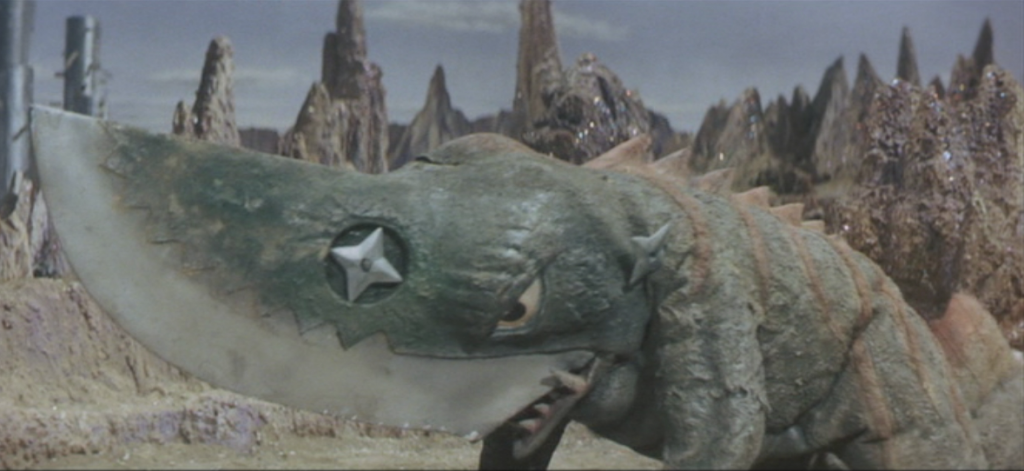
Gamera Vs. Guiron (1969)
In Gamera Vs. Guiron, two young boys sneak aboard a spaceship and find themselves whisked away to the mysterious planet Terra. There, they encounter Gamera’s old foe Gyaos and two female aliens with a taste for human brains. Gamera must save the children and battle the new monster Guiron, whose entire body is a living weapon.
The kids who serve as the focus for this fifth entry into the series are straight up jerks. Gamera is a friend to all children, but you kind of wish he would leave these two to fend for themselves after they find themselves whisked away to a faraway planet. There is an amusing scene early in the film where Gamera tries to warn the children about the danger they are in, but the two cannot help but get into a situation where they need to be saved. The series has never had picture perfect costume and set design, but there is a noticeable drop in quality in the background of planet Terra in this picture. Budgets were slashed, and they could not hide it. This film once again recycles footage from the past, but it is not as overwhelming as the previous entry. The new foe Guiron is pretty dope, as he establishes his dominance early on by decapitating a version of Gyaos – the highlight of the film. The series really begins to lean into the camp as it has Gamera doing some gymnastics that will have you howling with laughter. You really won’t believe what you are seeing, so it’s worth watching for that alone.
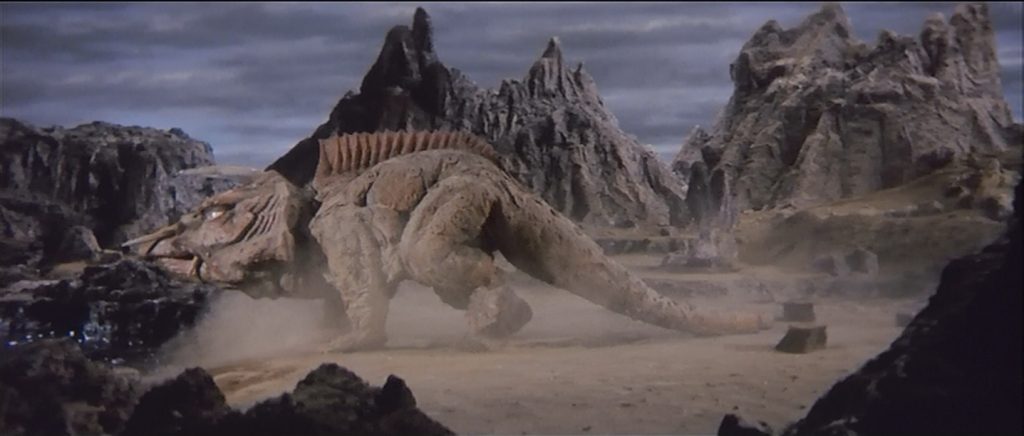
Disc Four
Gamera Vs. Jiger (1970)
In Gamera Vs Jiger, when a giant stone statue on Wester Island is disturbed, the legendary monster Jiger appears and heads for Japan. Gamera tries to stop this new arrival, only to be injured when Jiger lays eggs inside of him. As two boys in a submarine go on a dangerous quest inside of Gamera’s body to save him, Jiger threatens the Expo ‘70 world’s fair in Osaka.
This sixth entry mercifully makes the kids who we are following less like jerks this time around. Gamera shows up early on to try to stop humans from screwing over the environment by not unearthing a totem, but humans will always succeed in being the worst. This film bravely tackles such questions as, what would happen if Gamera got knocked on his back? We get a female foe this time in the form of Jiger, we know this because she impregnates Gamera via some crazy spike attack. Just when you think the series cannot get anymore ridiculous, it takes a page out of the Magic School Bus by having our lead kids get into a submarine, shrink down, and enter Gamera’s body to try to remove Jiger’s eggs. Yes, they literally go in his body, and I still cannot get over this fact. This almost makes the fact that Gamera introduces some straight up wrestling moves to his attack arsenal seem quaint. The movie is dumb fun to the greatest extent.
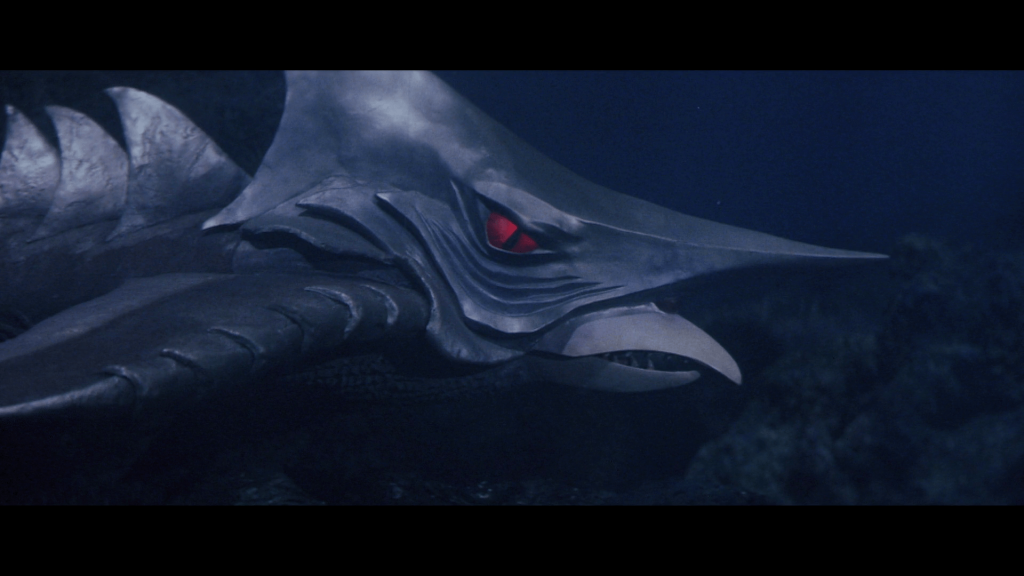
Gamera Vs. Zigra (1971)
In Gamera Vs Zigra, an alien woman from the planet Zigra and her spaceship create a series of earthquakes around the globe. Two children at a marine park are caught in the crossfire as Gamera must combat the monster Zigra to save the earth.
The last “proper” entry in the Showa era keeps up its streak of leaving you bewildered in a fun way. In an interesting turn of events, the majority of the film takes place at Sea World Japan. Seeing actual sea life is a fun treat if you set aside their problematic status as an abusive corporation. The adversary in this one stands out for the fact that it is the first monster to actually talk, even if only telepathically. Zigra gets to have a greater personality as he takes control of various parties while we await Gamera to come kick some butt. In the midst of waiting, we have scenarios such as the most obnoxiously long foot pursuit you have ever seen around Sea World as a henchmen pursues two children. Gamera is incapacitated for very long stretches of the film, but he makes the most out of his time when he is on screen. There is a point when he nonchalantly picks up a boulder to throw at a sleeping Zigra to test if he is awake that had me smiling big time. Although, the moment of the film has to go to Gamera plays Zigra’s back like a xylophone. This is the type of ice cold move that you have to respect.
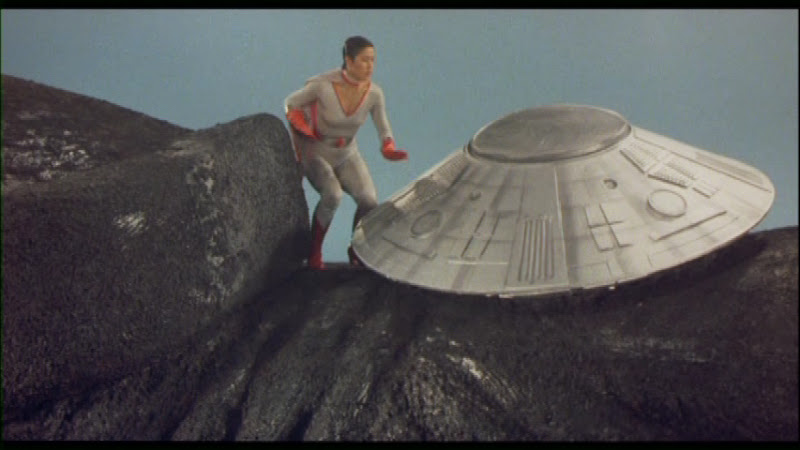
Gamera Super Monster (1980)
In Gamera Super Monster, as a massive alien craft heads to Earth to do evil, three good and powerful superwomen befriend a young boy who has a special connection to Gamera, and old foes return to do battle one more time.
Can we just forget this entry exists? This final entry into the Showa era brings nothing noteworthy to the proceedings, as all of the Gamera action ends up being clips from older films from the series. The new material is some very shoddily cobbled together story of space women coming together to fight the forces of evil as some kid just dreams of stuff Gamera did in the past. The visual effects of these women flying are horrendous. The only time the film really does anything fun is when the kid is playing a piano in the house and he taps out the Gamera theme song. There is also a quick jab or homage to Godzilla that at least feels like a bit of spice in an otherwise bland soup. This creative team should feel ashamed to call this a Gamera movie.

Video Quality
Gamera: The Showa Collection comes to Blu-Ray with eight films spread over four discs. These films share a lot of the same qualities, so I will mostly be judging them in groups while pointing out noticeable differences when necessary. Masters prepared by the Kadokawa Corporation for these eight Japanese films were provided to Arrow Video. Original 16mm and 35mm materials relating to the English language versions originally distributed in the United States by American International and Filmways were accessed courtesy of Metro Goldwyn Mayer, in association with the Kadokawa Corporation. Overall, these transfers represent something of a mixed bag in terms of quality. No one presentation in this set represents a 5-star effort, but the quality ranges from good to great. Every film suffers from some form of print damage and other source anomalies, but the severity varies from film to film.
The sole black and white film is Gamera The Giant Monster, so I will judge this one separately. There are minor nicks, and the occasional instance of more noticeable damage and flickering, but the film overall appears very natural and filmic. There is some noticeable softness to some of the shots that likely stems from the quality of the source material. Film grain is present without being too intrusive, save for a few moments that verge on noise. For the most part, this lack of noise reduction allows details not to be scrubbed away. Textures on clothing and within the production design are way more apparent than they would have been on DVD. The contrast in the black-and-white photography fluctuates at times, but mostly remains stable. Black levels could stand to be quite a bit deeper, and crush serves as more of an issue than is typical for an Arrow release. Even with its issues, this release is a big step up from the previous Mill Creek release.
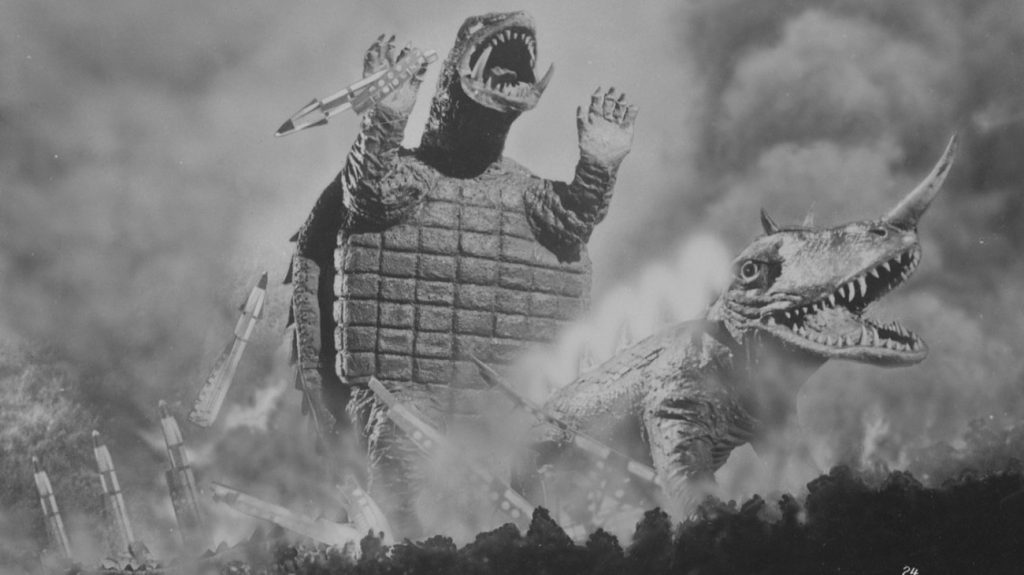
The next tier of films from Gamera Vs. Barugon to Gamera Vs. Zigra offers an experience that I would deem to be good, but the films have noticeable issues that can be hard to overlook. These six films handle the basics fairly well such as color saturation, but not all transfers are as vibrant as you might hope. Fine detail should be chalked up to middling to strong with some films presenting as soft or even a bit unfocused in some shots. The strongest effort overall is surprisingly Gamera Vs. Barugon, which is both natural and consistent throughout. These films occasionally suffer from instances of black crush or other digital anomalies. Print damage does not serve as a major issue among these titles. Some of the natural film grain appears like it was attempted to be scrubbed clean which robs the image of detail. While viewing these films in motion you might not be as critical of certain elements, but they are present when you are really looking.
The final film Gamera Super Monster is what would be considered to be inferior quality by any discerning person. This is not necessarily an issue with the disc, but more so a baked-in deficiency with the opticals in the film. The film also uses pretty consistent clips from previous films that are not as in good of shape as the actual films on the other discs. Many of these scenes are not presented in their OAR, which is how the film chose to display them for some reason. This transfer falls victim to really ill-defined textures and some overly thick grain that can be a bit much. The presentation is a step up from DVD, but this just appears dull and lifeless compared to other transfers. The source material is keeping these films from being a god-send, but this set provides Blu-Ray that are quite good looking for the most part.
Audio Quality
This Blu-Ray set presents these eight films with DTS-HD Master Audio Mono tracks in the original Japanese as well as English dubs – sometimes more than one in the case of a few of these titles. Dialogue is crystal clear and easily distinguishable throughout this set of films. These films employ some atmospheric sound effects in the mix that thankfully do not get muddled. The score maintains a pleasing fidelity among these titles, and there does not appear to be many egregious instances of age related wear and tear. At worst there is a minor bit of brashness in the upper registers, but this is not a consistent issue. All eight films included in this set have optional English subtitles provided. This series is not an audio powerhouse, but it mostly gets the job done in a pleasing way.
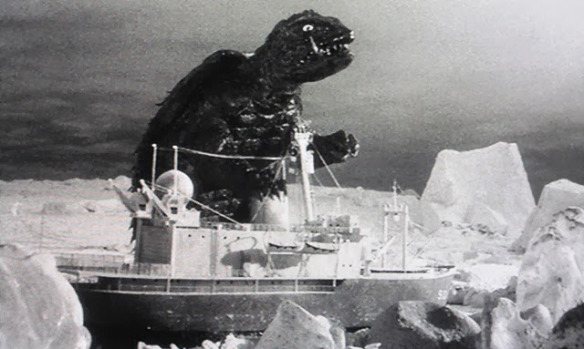
Special Features
Disc One – Gamera The Giant Monster
- Audio Commentary: Author August Ragone provides an information-rich commentary track that discusses the film’s place in cinema, the careers of the performers, the production of the film and more. These insights are quite interesting and should be quite compelling to fans of the series.
- Introduction: A 13-minute piece in which Ragone delivers an enlightening examination of the character and the state of sci-fi and kaiju films at the time of its release. This is a great primer for newcomers to understand the history at play.
- Gammera The Invincible: The 86-minute US version of the film is included here which is presented with English dubbing and additional scenes directed by Sandy Howard. This version is obviously not better, but it is an interesting alternative for those who grew up with this version.
-
- US Theatrical Trailer: The minute-and-a-half trailer is provided here with the American voice over taking audiences through the story.
-
- Theme Song: The four-minute silly theme US theme song is provided here.
- Remembering the Gamera Series: A 23-minute retrospective documentary from 1991 featuring crew members reflecting on the series. The most interesting part of this is getting a look at the unmade Gamera vs. Garasharp.
- Interview with Noriaki Yuasa: A 13-minute interview with director Noriaki Yuasa filmed by Jōrg Buttgereit in 2002 at Daiei Studios in which he discusses his competition with Godzilla, the reason this era of the character was geared towards children, the legacy of the Showa era and more.
- Gamera Special: A two-part 58-minute special which compiles things like trailers and fight scenes, originally released on VHS in 1991 with supervision by Noriaki Yuasa. If you only want the destruction, this is your way to go, but it has not been beautifully remastered like the feature films.
- Alternate English Credits: A five-minute alternative to the opening of the film can be viewed here.
- Original Japanese Trailer: The two-minute Japanese trailer is provided here with English subtitles.
- US Video Promo: The minute-long home video promo complete with cheesy voiceover.
- Image Gallery: A collection of stills, promo materials, behind-the-scenes photos and more are provided here.

Disc Two – Gamera Vs. Barugon / Gamera Vs. Gyaos
Gamera Vs. Barugon
- Audio Commentary: Author August Ragone and project translator and Gamera fan Jason Varney deliver a fun and informative commentary track in which they discuss changes from the screenplay, the cinematography, performers in the film, the creative decisions regarding tone and more.
- Introduction: An 8-minute piece in which Ragone gets the audience up to date on the narrative and its place in Japanese cinema.
- War of the Monsters: An 88-minute US version of the film that trims twelve minutes from the runtime in an effort to establish a faster pace.
- Alternate English Credits
-
- American International Version: This minute-long version has a lot in common with the theatrical version.
-
- Sandy Frank Version: This two-minute version seems very basic and low rent compared to the actual credits.
- Theatrical Trailers: Three trailers are provided for the film, including a texted and textless version of the same trailer.
- Image Gallery: A collection of stills, promo materials, behind-the-scenes photos and more are provided here.
Gamera Vs. Gyaos
- Audio Commentary: Film Historian Stuart Galbraith IV delivers a highly informative commentary track in which he discusses the film being targeted toward children, secrets of the set design, talent on screen, financial strains for the studio and more.
- Introduction: A 9-minute piece in which Ragone gets the audience up to date on the narrative and discusses how the film tried to bring in societal problems into the narrative.
- Alternate English Credits
-
- American International Version: A minute-long look at the Return of the Giant Monsters opening.
-
- American International Alternate Footage: Examples of footage that was included of Americanized signage in different aspect ratios.
-
- Sandy Frank Version: A nearly five-minute alternate version that once again looks supremely lazy.
- Theatrical Trailers: The disc includes a Japanese trailer, German trailer, US TV spot, and US Video spot.
- Image Gallery: A collection of stills, promo materials, behind-the-scenes photos and more are provided here.

Disc Three – Gamera Vs. Viras / Gamera Vs. Guiron
Gamera Vs. Viras
- Three Versions of the Film
-
- Theatrical Version (1080p; 1:12:14)
-
- Director’s Version (1080p; 1:21:17)
-
- US Extended Version (1080p; 1:30:24)
- Audio Commentary: Actor Carl Craig and special features producer Jim Cirronella provide the first commentary track that delivers a first-person account from the production of the film. This is way more relaxed and personal than the other tracks, which makes for a great listen.
- Introduction: An 11-minute piece in which Ragone discusses how American International Pictures helped to continue the series with American distribution, the new stipulations put on the production, the (lack of) cooperation with the Boy Scouts of Japan and more.
- Gamera Vs. Viras – 52 Years Later: A nearly 13-minute featurette in which actor Carl Craig shows off some of the props and photos from his time on the film.
- G-Fest 2003 Highlights: An hour-long special in which Gamera creator Noriaki Yuasa and actor Carl Craig attend the Chicago festival in 2003 and discuss their experiences and answer fan questions.
- The 4th Nippon Jamboree: A six-minute promo video for the Boy Scouts of Japan directed by Noriaki Yuasa.
- Alternate English Credits: A minute-and-a-half alternate credits sequence for Destroy All Planets.
- Theatrical Trailers: The disc includes a Japanese trailer and a US TV spot.
- Image Gallery: A collection of stills, promo materials, behind-the-scenes photos and more are provided here.
Gamera Vs. Guiron
- Audio Commentary: Film Historian David Kalat provides a passionate commentary track that lovingly delves into the childish nature of the production.
- Introduction: An 11-minute piece in which Ragone discusses the unexpected second life for the film, the inclusion of the space race into the film, how the school grades of the actors were of grave importance to the production and more.
- Alternate English Credits:
-
- American International Version: The nearly three-minute opening credits for Attack of the Monsters complete with English voiceover.
-
- Sandy Frank Version: The nearly three-minute opening credits that differs slightly from the version previously.
- Theatrical Trailers: The disc includes a Japanese trailer and a US TV spot.
- Image Gallery: A collection of stills, promo materials, behind-the-scenes photos and more are provided here.
- Neptune Media Archive Gallery: The original artwork and pictures of supplemental items from the first US distributor to release Gamera films in their original forms.

Disc Four – Gamera Vs. Jiger / Gamera Vs. Zigra / Gamera Super Monster
Gamera Vs. Jiger
- Audio Commentary: Film Historian Edward H. Holland provides a deliberately paced commentary track that delves into the history of the film and the legacy it has left behind.
- Introduction: An 9-minute piece in which Ragone discusses the impact of the Expo on the script, the expanded budget, the inclusion of some wrestling-style moves in the fighting and more.
- Alternate English Credits: The minute-long credits for Gamera Vs. Monster X are provided here.
- Theatrical Trailers: The disc includes a Japanese trailer, a German trailer and a US TV spot.
- Image Gallery: A collection of stills, promo materials, behind-the-scenes photos and more are provided here.
Gamera Vs. Zigra
- Audio Commentary: Co-Authors Sean Rhoads and Brooke McCorkle provide a relaxed and informative commentary track that delves into the history, reveals some tales from the production, offers background information on the performers and more.
- Introduction: An 8-minute piece in which Ragone discusses the dire financial straits of Daiei Studios, the mandates from Sea World, the connections of the cast to previous installments and more.
- Alternate English Credits: The minute-long credits for Gamera Vs. Zigra from the US cut are provided here.
- Theatrical Trailers: The disc includes a Japanese trailer and a US TV spot.
- Image Gallery: A collection of stills, promo materials, behind-the-scenes photos and more are provided here.
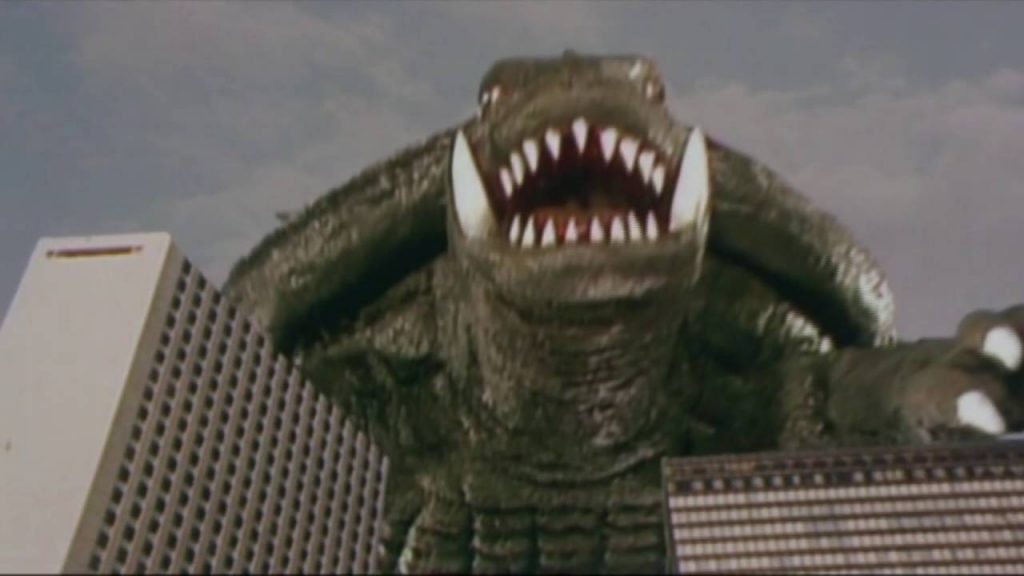
Gamera Super Monster
- Audio Commentary: Film Historian Richard Pusateri provides a fun and snarky commentary track which does not let this film off the hook for its basic ineptitude and laziness. An amusing listen.
- Introduction: A 6-minute piece in which Ragone discusses the cobbled together nature of the film and gives as much background information as possible for those who are interested.
- Alternate English Credits
-
- Gamera Super Monster (16mm): The five-minute credits for Gamera Super Monster are provided here.
-
- Super Monster (VHS): The six-minute VHS credits are provided here.
- Theatrical Trailers: The disc includes a Japanese trailer and a English trailer.
- Image Gallery: A collection of stills, promo materials, behind-the-scenes photos and more are provided here.
Final Thoughts
The Showa Era of Gamera is not some masterclass on the art of cinema, but it is often very entertaining once you embrace the cheesy moments. The first film is legitimately a pretty interesting monster flick, and the remainder of the series embraces the ridiculousness of a giant rubber turtle fighting a cavalcade of other rubber monsters. The designs of his adversaries deliver a strong lineup of visually distinct characters to root against during these knock down, drag out fights. Arrow Video has delivered an amazing box set that honors this giant flying turtle with a strong A/V presentation and an assortment of special features that will keep fans busy for quite a while. If you have a soft spot in your heart for cheesy kaiju films, Gamera: The Showa Era will provide hours of fun. Recommended
Gamera: The Showa Era is currently available to purchase on Blu-Ray.
Note: Images presented in this review are not reflective of the image quality of the Blu-Ray.
Disclaimer: Arrow Video has supplied a copy of this set free of charge for review purposes. All opinions in this review are the honest reactions of the author.

Dillon is most comfortable sitting around in a theatre all day watching both big budget and independent movies.


